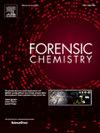Determining extent and distribution of methamphetamine in cars: Air vs. surface vs. fabrics
IF 2.6
3区 医学
Q2 CHEMISTRY, ANALYTICAL
引用次数: 0
Abstract
Methamphetamine can be manufactured or smoked in vehicles resulting in contamination. In addition, the transportation of drugs between place of manufacture and distribution can lead to contamination. Subsequent passengers or drivers of contaminated vehicles could be exposed to thirdhand drugs. Individuals exposed to thirdhand contamination have shown adverse health symptoms including respiratory problems, headaches, and behavioural and cognitive issues. Therefore, it is important to determine the overall methamphetamine contamination extent of cars to protect public health. This study was undertaken to determine the extent and distribution of contamination on surfaces, in air and from porous materials in two cars that tested positive for methamphetamine. Air sampling was performed in two cars using two sorbent tube types, followed by solvent desorption, and analysis using liquid chromatography tandem mass spectrometry (LC–MS/MS). Additionally, surface wipe sampling and bulk material sampling was performed for one of the contaminated cars that was going to be destroyed. These results demonstrated that methamphetamine can be detected in air, on the surfaces of non-porous and porous materials and from within porous materials. Results also demonstrated that methamphetamine was still detected from a second, third and fourth wipe sampling event of a plastic surface, indicating that there is a necessity for further research on testing and remediation in cars.

确定甲基苯丙胺在汽车中的程度和分布:空气、表面和织物
甲基苯丙胺可以在车辆中制造或吸食,从而造成污染。此外,药品在生产地和分销地之间的运输可能导致污染。受污染车辆的后续乘客或司机可能会接触到三手药物。接触三手污染的个人表现出不利的健康症状,包括呼吸问题、头痛以及行为和认知问题。因此,确定汽车甲基苯丙胺的总体污染程度对保护公众健康具有重要意义。进行这项研究是为了确定两辆甲基苯丙胺检测呈阳性的汽车表面、空气和多孔材料中污染的程度和分布。采用两种类型的吸附管在两辆车中进行空气采样,然后进行溶剂解吸,并使用液相色谱-串联质谱(LC-MS /MS)进行分析。此外,对其中一辆即将被销毁的受污染汽车进行了表面擦拭取样和散装材料取样。这些结果表明,甲基苯丙胺可以在空气、非多孔材料和多孔材料表面以及多孔材料内部被检测到。结果还表明,在塑料表面的第二次,第三次和第四次擦拭取样事件中仍然检测到甲基苯丙胺,这表明有必要进一步研究汽车的测试和补救措施。
本文章由计算机程序翻译,如有差异,请以英文原文为准。
求助全文
约1分钟内获得全文
求助全文
来源期刊

Forensic Chemistry
CHEMISTRY, ANALYTICAL-
CiteScore
5.70
自引率
14.80%
发文量
65
审稿时长
46 days
期刊介绍:
Forensic Chemistry publishes high quality manuscripts focusing on the theory, research and application of any chemical science to forensic analysis. The scope of the journal includes fundamental advancements that result in a better understanding of the evidentiary significance derived from the physical and chemical analysis of materials. The scope of Forensic Chemistry will also include the application and or development of any molecular and atomic spectrochemical technique, electrochemical techniques, sensors, surface characterization techniques, mass spectrometry, nuclear magnetic resonance, chemometrics and statistics, and separation sciences (e.g. chromatography) that provide insight into the forensic analysis of materials. Evidential topics of interest to the journal include, but are not limited to, fingerprint analysis, drug analysis, ignitable liquid residue analysis, explosives detection and analysis, the characterization and comparison of trace evidence (glass, fibers, paints and polymers, tapes, soils and other materials), ink and paper analysis, gunshot residue analysis, synthetic pathways for drugs, toxicology and the analysis and chemistry associated with the components of fingermarks. The journal is particularly interested in receiving manuscripts that report advances in the forensic interpretation of chemical evidence. Technology Readiness Level: When submitting an article to Forensic Chemistry, all authors will be asked to self-assign a Technology Readiness Level (TRL) to their article. The purpose of the TRL system is to help readers understand the level of maturity of an idea or method, to help track the evolution of readiness of a given technique or method, and to help filter published articles by the expected ease of implementation in an operation setting within a crime lab.
 求助内容:
求助内容: 应助结果提醒方式:
应助结果提醒方式:


